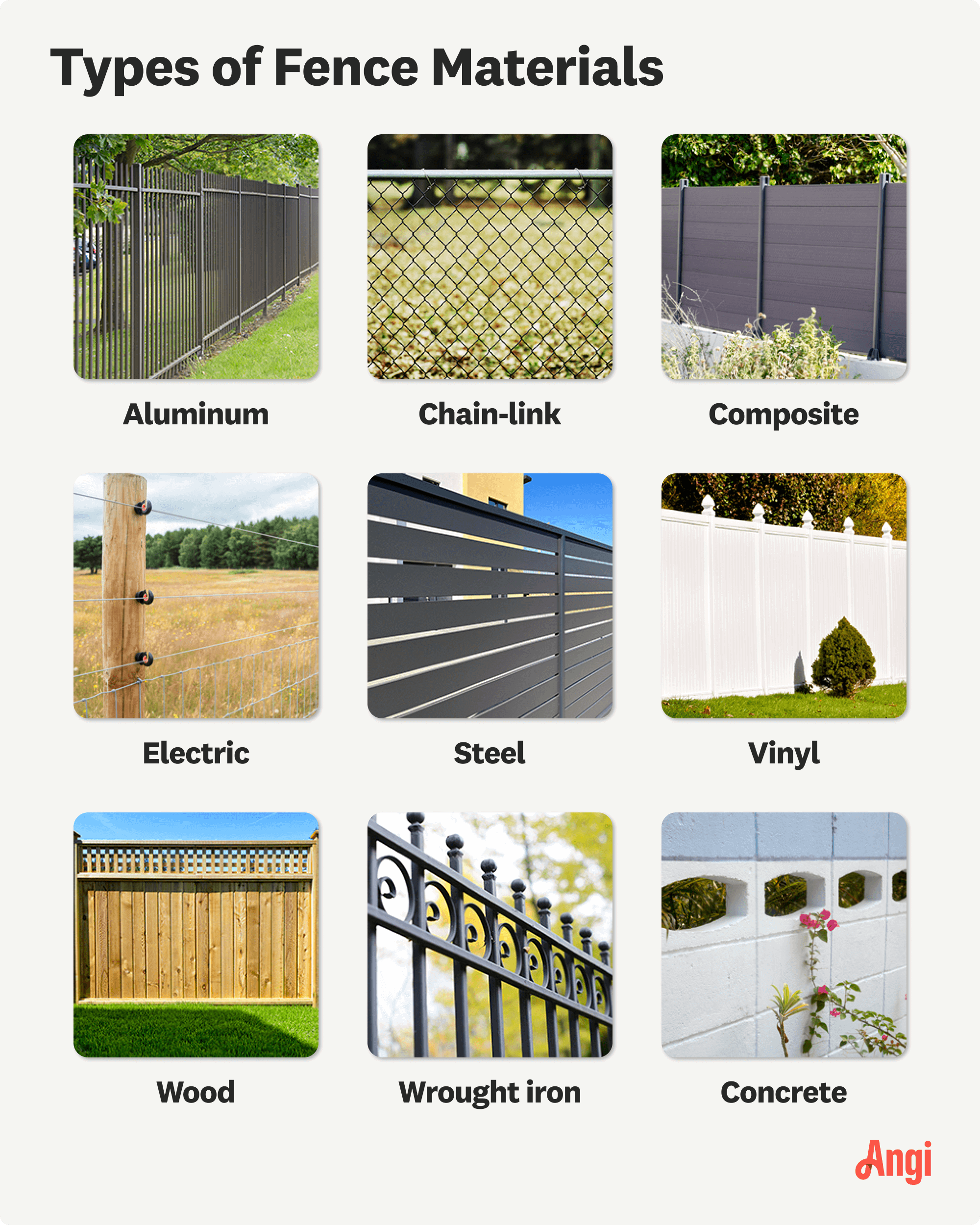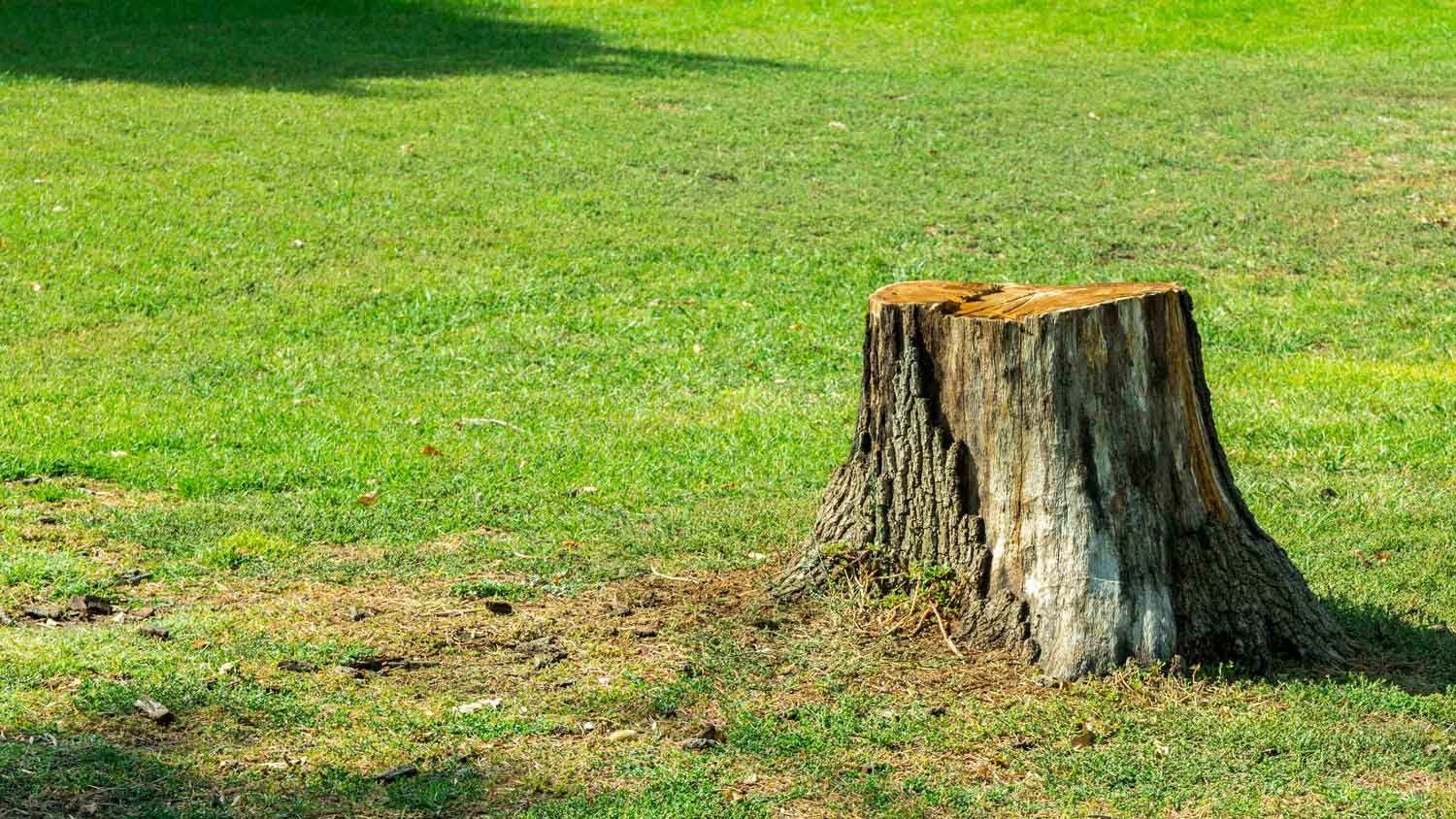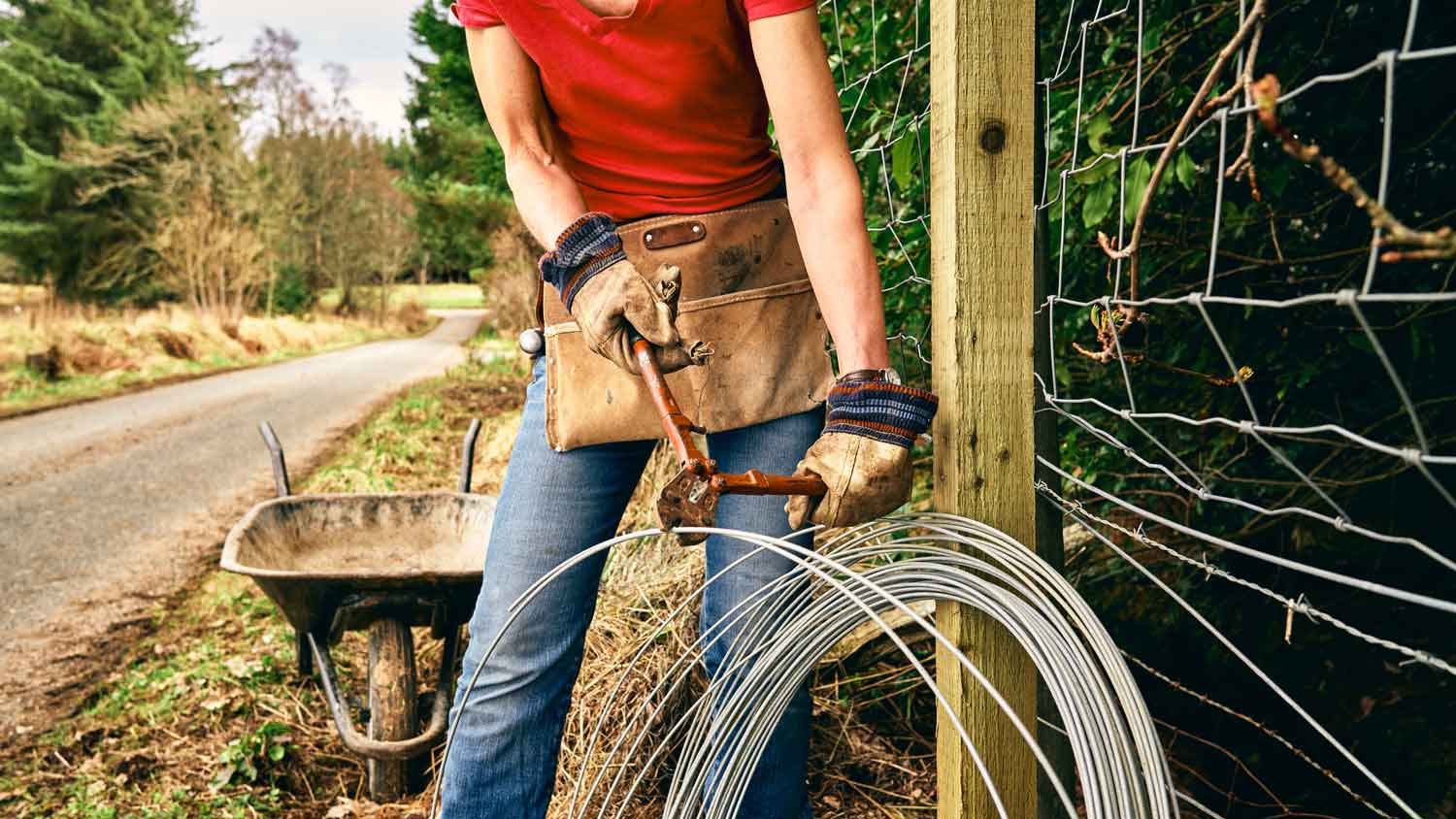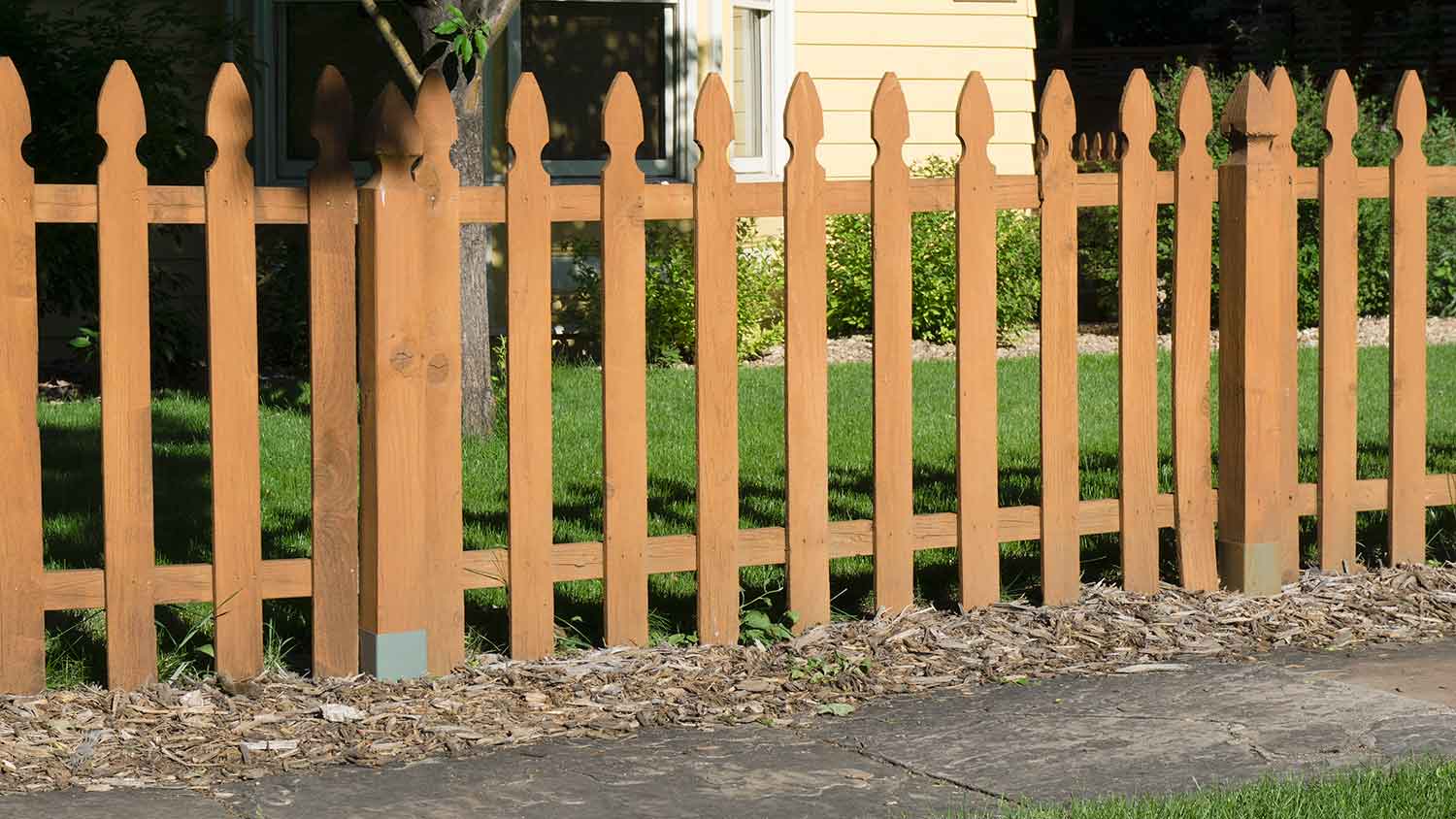How Much Does Fence Installation Cost? [2025 Data]
The average U.S. homeowner spends about $3,220 to install a fence, but most spend between $1,857 and $4,763. Your fence pro will factor in the length and material of your fence for an accurate quote.


The amount of material you use is the biggest cost factor, meaning taller or longer fences or those with less space between posts are more expensive.
Gates start around $150 per opening, so don’t forget to budget this into your cost.
Wood fences are more affordable per square foot than other options like composite or vinyl, but staining isn’t exactly wallet-friendly (although it is easy to DIY.)
Fence installation costs an average of $3,220, but your total depends on the type of fence you want, the length, height, and other factors. Most homeowners pay between $1,857 and $4,763 for fence installation. In this guide, we’ll explain the factors that influence your fence installation price to help you get an accurate estimate for your home improvement project.
Fence Installation Cost Factors
There are a few factors that will affect the total cost, including the length of the fence, the fence height, the type of fence you want, and more.
Fence Size
The cost to install a fence can vary based on the amount of material used, which is, in large part, determined by the size of your fence. Longer fences will naturally cost more due to higher material costs and labor costs to install them.
Common prices for a residential backyard fence by linear foot include:
100 linear feet: $2,300
150 linear feet: $3,600
300 linear feet: $6,900
This all comes out to an average cost per linear foot for fence installation of between $6 and $50, depending on the material, with an average per-linear-foot cost of $23.
| Lot Size | Linear Feet | Average Fence Cost |
|---|---|---|
| 1/8 acre | 150 | $3,500 |
| 1/4 acre | 220 | $4,850 |
| 1/2 acre | 590 | $13,570 |
| 1 acre | 1,100 | $24,000 |
| 2 acres | 2,200 | $45,000 |
Type of Fence
The type of fence you choose is another important factor affecting cost. For instance, if you want to block the view of your yard entirely, a privacy fence costs around $35 per linear foot. No matter the type of fence you choose, a privacy fence will always require more material to provide a barrier, so the cost will be higher. Shorter decorative fences will likely be more affordable.
Materials
You can choose from many fencing materials, including wood, iron, aluminum, PVC, and chain-link. The costs vary wildly among the different fencing materials, with chain-link fences tending to be the most affordable, followed by wood, iron, PVC, and then aluminum.

The pricing of each material varies based on the design of the fence, though, so your total will depend on your front yard fence idea.
Here's the average fence installation cost by material so you can compare against your budget:
| Fence Material | Typical Cost Range | Cost to Fence a ¼ Acre Lot (two sides) |
|---|---|---|
| Aluminum | $17–$90 per linear foot | $3,550–$18,800 |
| Chain-link | $8–$40 per linear foot | $1,650–$8,300 |
| Composite | $11– $45 per linear foot | $2,250–$9,400 |
| Electric | $2–$4 per linear foot | $420–$850 |
| Privacy | $25–$40 per linear foot | $5,250–$8,300 |
| Steel | $17–$90 per linear foot | $3,550–$18,800 |
| Vinyl (PVC) | $15–$40 per linear foot | $3,150–$8,300 |
| Wood | $10–$45 per linear foot | $2,100–$9,400 |
| Wrought iron | $25–$55 per linear foot | $5,250–$11,400 |
| Concrete (Cinder block) | $10–$30 per linear foot | $2,100–$6,250 |
Labor
Your labor costs usually account for about 50% of your total project costs. On average, labor costs for fence installation will total around $1,600. Who you hire to build a fence might charge more for heavy fencing, like wrought iron, while charging less for lighter fencing that’s easier to cut and work with, like PVC. Additionally, labor costs vary for prep steps like stump or tree removal, land leveling, or fence removal.
Hiring a professional for your fence project can lead to significant long-term cost savings. Professionals use high-quality materials and adhere to best practices, resulting in a durable fence that requires fewer repairs and replacements. They also bring expertise that helps avoid costly mistakes common in DIY projects, such as improper installation or non-compliance with local regulations.
Permits
Permit requirements vary by city and local laws, but you’ll almost always need a permit to put up a fence, especially if it’s going to be located near your property lines. Fencing permits won’t add much to your total, as they cost between $20 and $60, on average.
Again, your fence installation company will usually include the cost of the permit and filing fees in your estimate, but you’ll have to budget for this separately if you’re installing your fence yourself.
Gates and Other Features
Gates are considered a specialty feature because they require additional work and materials. While some gates won't cost more than $150, you could pay $400 to $1,200 per side gate, depending on the material, or a few thousand dollars for automatic driveway gates.
Gates: $150–$2,000
Concrete for post bases: $0.30 per pound
Post caps: $30–$150 per cap
Fences are primarily a means of privacy, but they’re also helpful for homeowners with pets. They are not designed to keep people out. If you’re looking to increase your home’s security, we recommend other methods, such as installing security cameras.
Removing an Existing Fence
If you’re replacing a fence rather than installing a new one, you’ll need to remove the old one before you can begin your installation. Fence removal costs $3 to $5 per linear, with most spending $450 to $750 to remove 150 feet of fencing. You might also need to pay for dumping fees unless you can recycle or scrap the material.
Land Leveling
Installing a fence on a slope is more costly and time-consuming, either because the land needs leveling or because your fence installer needs to manipulate the fence materials to align with the slope and still secure your yard. In some cases, you may only be able to install your fence if you pay for leveling.
Most homeowners spend $1,000 to $3,200 to regrade their lawn prior to fence installation.
Tree Removal

You’ll need to remove trees and roots that interfere with your fence installation.
Cost to remove a tree: $750
Remove a short tree: $200
Remove a tree taller than 80 feet: $2,000
Root removal for fence posting: $50 per instance
Landscaping
Though most spend somewhere between $1,300 and $5,900 per landscaping project, it depends on the type of services.
Sod installation: $1–$3 per square foot
Border plants: $2–$50 per plant
Mulching: $30–$120 per cubic yard
Topsoil installation: $12–$30 per cubic yard
Paver installation: $10–$30 per square foot
Matching deck rails to fencing: $10–$50 per linear foot
Stump removal: $100–$150, plus $50 per additional stump
Working Around Underground Utilities
If you need to work around underground utilities, expect your costs to increase.
Underground utilities can pose a problem for any project that requires digging, although standard lines should be deep enough that they aren’t an issue for regular installation. Still, hitting a power line or gas line can be a serious hazard. Have your contractor check for utilities or call Dig Safe before you begin.
Painting and Staining
Painting or staining a fence costs $3.50 to $13 per linear foot for a professional job, with most homeowners spending $750 to $4,250 per project. However, this is also a popular DIY project—particularly if you’re dealing with a wooden fence, which usually is the most affordable and straightforward to paint. In that case, you’ll just have to spend on materials.
How Much Does a Fence Cost by Location?
Fence installation companies base their rates on the local market—and their competitors. Regions with a higher cost of living will likely mean your local fence contractor will charge more for their labor and fence materials. Similarly, some homeowners associations (HOAs) require that you only install fences made of certain materials, such as aluminum or vinyl. If you live in an area with multiple HOAs, you may pay more for those fencing materials due to high demand.
We've broken down the average cost to install a fence by location across the U.S. so you can get a better idea of what you might pay:
Installing a Fence Yourself vs. Hiring a Pro

On average, you can save around $1,700 on the labor if you choose to install your fence yourself. This will vary based on the fence material, temporary fencing, and add-ons. When you install a fence yourself, you’ll need to rent equipment, obtain the correct permits, and buy the material. You'll also need the appropriate tools, including a post-hole digger, drill, circular saw, and shovel.
Your best bet is to hire a fencing professional who can complete the project in about 20 to 30 hours, saving you the hassle of sourcing permits, materials, and equipment. That way, you can rest assured that your fence construction is legal, up to code, and won’t need to be redone. Hire a fence company near you to make sure the job is done correctly the first time around.
Replacing vs Repairing a Fence
Repairing a fence usually costs less up-front than replacing it. Repairs, like fixing broken boards, patching small sections, or repainting, typically cost between $150 and $900. The exact cost depends on the material, the extent of the damage, and local labor rates.
Replacing a fence is a bigger expense, costing most homeowners between $1,775 and $4,565. The final price depends on the type of fence, its size, and its height. While replacement costs more initially, it often lasts longer and requires less upkeep, especially if the fence is old or badly damaged.
When deciding whether to repair or replace your fence, think about the short-term cost versus the long-term benefit. Consider the current condition of your fence, how it looks, and how much longer it’s likely to last. This will help you decide which option is the better investment for your home.
Ways to Save Money on Installing a Fence

Here are some tips to help you save on fence installation costs.
Choose a budget-friendly material: You’ll want to choose affordable materials, but you’ll need to keep maintenance in mind. Pick a material that has the right balance of budget, aesthetics, and durability.
Keep the design simple: If you need to keep a strict budget, consider skipping out on additional gates, upgraded finishes, ornate styles, special features, and added landscaping services.
Less pickets: To tighten your budget, choose a fence style that requires fewer pickets. Pickets with decorative tips cost more, so choose a simple, rectangular picket for the most cost-effective option.
Minimize posts: Posts are one of the most expensive parts of a fence because it takes time to set them correctly in the ground. You can reduce costs by choosing a design with fewer posts.
Get quotes from three contractors: Before you hire a fence contractor, take a look at the market. To get the biggest bang for your buck, interview at least three contractors and always check their references.
Book during off-season: Though you can’t dig into frozen ground, you can sometimes save money by booking your job during winter or late fall as long as the climate allows. Winter is a slower season for fencing contractors—so they’re much more likely to cut you a deal.
DIY when you can: You can save on fence installation costs by doing some of the labor yourself—like painting or removing an old fence.
Does Installing a Fence Increase a Home’s Value?
Depending on the material, design, and local market preferences, installing a fence can recoup up to 50% or more of its installation cost in resale value. Durable materials like vinyl, aluminum, or wrought iron offer higher returns due to their longevity and low maintenance.
Privacy is another key factor—tall fences that block views and reduce noise attract buyers seeking security and quiet. Beyond function, the fence's appearance influences value. A design that matches the home’s style and enhances curb appeal appeals to buyers, while a mismatched or poorly maintained fence can lower the home’s desirability. A well-built and well-chosen fence will offer a substantial return on investment.
How Angi Gets Its Cost Data
Home is the most important place on earth, which is why Angi has helped more than 150 million homeowners transform their houses into homes they adore. To help homeowners with their next project, Angi provides readers with the most accurate cost data and upholds strict editorial standards. We’ve surveyed over 30,000 real Angi customers about their project costs to develop the pricing data you see, so you can make the best decisions for you and your home. We pair this data with research from reputable sources, including the U.S. Bureau of Labor Statistics, academic journals, market studies, and interviews with industry experts—all to ensure our prices reflect real-world projects.
Want to help us improve our cost data? Send us a recent project quote to costquotes@angi.com. Quotes and personal information will not be shared publicly.
Frequently Asked Questions
Privacy fences in residential neighborhoods tend to stand between 6 and 8 feet tall, but local building code usually dictates the maximum height. Livestock fences that border large land plots range from 3 to 6 feet. Shorter, decorative fences, which are common in front yards, are around 3 feet tall, on average. Fence height also tends to vary by material, with wood fences usually sitting at 6 feet tall, and chain-link and wrought iron fences tending to sit at half that.
The best time to install a fence is in the fall and winter—the slow season for fencing companies. You’ll find a more open schedule with companies and possibly a lower cost due to lower demand. Additionally, the plants in your yard will most likely be dormant, so trees and other plans are less likely to incur damage or get in the way during the installation.
For people with standard-sized yards, building a fence will take between two and four days. The time it takes to build a fence depends on the materials you use, the size of the fence being built, and your experience in either building fences or working on large projects with your hands. Permits, weather issues, and construction can significantly slow your build time.
Fences will last anywhere from five to 30 years, depending on the material. Chain-link fences and barbed wire fences can rust quickly, which lowers their life spans. Vinyl and composite are more durable because they don’t rust, and you don’t need to seal them regularly like you would wood fences. When properly maintained, though, most fence materials should last for between 15 and 30 years.
Most homeowners don't need to inform their neighbors before constructing a fence, according to the law, but you will need to make sure that you’re building on the property line or on your side of the property line. Otherwise, the neighbor could complain, which would require you to tear down and reinstall the fence. In any case, keeping them in the loop is the neighborly thing to do!
Whether you inform your neighbors or not, always use property records and a land survey to ensure your fence stays within your property boundaries.
















